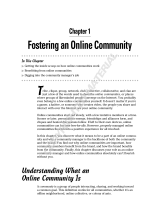Page is loading ...

Chapter 1
Sharing Your Thoughts,
140 Characters at a Time
In This Chapter
▶ Understanding what Twitter’s all about
▶ Seeing how individuals, organizations, and businesses use Twitter
▶ Discovering what you can do with Twitter
▶ Looking into third-party Twitter applications
Y
ou may have heard of Twitter but have no idea what it actually is.
Twitter is basically a powerful mobile social network that allows you
to keep up with the people, businesses, and organizations you’re interested
in — whether you know them personally or not. It also lets you share what
you’re doing with the world — everyone from your family and friends to
complete strangers. (You’ll have to bear with us to find out why you would
want to do that.) Harvard Professor Andrew McAfee (@amcafee) describes
Twitter this way: “With Twitter, my friends are never far away.”
And www.twitter.com itself says that The New York Times calls Twitter
“one of the fastest-growing phenomena on the Internet.” Time magazine says,
“Twitter is on its way to becoming the next killer app,” and Newsweek noted
that “Suddenly, it seems as though all the world’s a-twitter.” What will you think?
Every day, we see dozens of new ideas and ways to use Twitter. In this chap-
ter, we do our best to introduce the basic ideas and explain how Twitter
works and why it’s so powerful.
06_768792-ch01.indd 906_768792-ch01.indd 9 6/28/10 9:42 PM6/28/10 9:42 PM
COPYRIGHTED MATERIAL

10
Part I: Twitter? Like Birds Do?
Figuring Out This Twitter Thing
Twitter is a fast-evolving, surprisingly powerful new way to exchange ideas
and information, and to stay in touch with people, businesses, and organiza-
tions that you care about. It’s a social network — a digital abstraction that
represents who you know and who you’re interested in (whether you know
them personally or not) — that you can access from your computer, your
cellphone, or anywhere with an Internet connection.
Twitter has one central feature: It lets users instantly post entries of 140
characters or less, known as tweets, through the www.twitter.com site or
your cellphone, or by way of the numerous applications that are available for
both. (We talk more about the different ways to tweet in Chapters 8 and 9.)
On the most basic level, Twitter is a communications network that combines
elements of Short Message Service (SMS or texting), instant-messaging com-
munication tools, such as AOL Instant Messenger (AIM), and blog publish-
ing software, such as Blogger or WordPress. Like blogging, your tweets are
generally published to the world at large where anyone can read them on
Twitter.com (unless you choose a private account, so that only those you
choose can see your tweets). Unlike blogging, you’re limited to just 140 char-
acters. Like instant messaging, you can communicate directly with people
(through direct messages), but unlike instant messaging, each message has
its own unique resource locator (URL), so each message is actually a Web
page. Instant messaging also lacks the social network “following” features of
Twitter and basic ideas like “publish-subscribe” and one-to-many broadcast-
ing of messages. Think you can’t say anything meaningful in 140 characters?
Think again. Not only are twitterers innovating clever forms of one-liners,
haiku, quotes, stories, and humor, but they’re including links — in 23 percent
of all tweets by one measure — and links carry a lot more information and
context. Writing 140-character messages seems trivial. But headlines and
very short advertising copy are famously hard to do really well — and the
right words can be quite powerful. Consider: “Man Lands On Moon.”
The idea of Twitter sounds simple — deceptively simple. When you think
about how millions of people around the world are posting Twitter messages,
following other people’s Twitter streams, and responding to one another, you
can start to see the significance behind Twitter’s appeal. In fact, Twitter has
noticed that it acts like a “pulse of the planet,” a zeitgeist of what everyone is
thinking about and doing and feeling, right now. Now that’s pretty interesting!
True, Twitter can look like it’s full of noise. But, once you find interesting
people and accounts to follow, your Twitter stream shifts from a cascade of
disjointed chatter to one of the most versatile, useful online communications
tools yet seen — that is, if you take the time to learn to use that tool correctly.
06_768792-ch01.indd 1006_768792-ch01.indd 10 6/28/10 9:42 PM6/28/10 9:42 PM

11
Chapter 1: Sharing Your Thoughts, 140 Characters at a Time
In the beginning was the word:
The origins of Twitter
Twitter connects a wildly diverse array of
people from all over the world, erasing barriers
and boundaries all the way. Some of the media
hype has called Twitter nothing short of revolu-
tionary. And because Twitter is so easily cus-
tomizable and open-ended, it has continued to
become more and more popular with people
and companies.
But Twitter’s beginnings, like so many other dig-
ital innovations, were humble. Twitter was built
in 2006 by three technology entrepreneurs —
Evan Williams, Biz Stone, and Jack Dorsey. All
three were then employed by a San Francisco–
based Web company called Odeo, which spe-
cialized in publishing software for podcasting
(audio broadcasting over the Web). Dorsey was
the one who came up with the original concept,
and the three subsequently built it as an internal
tool for Odeo employees. At first, they had no
idea that it would catch on the way it did.
A management shakeup led to Twitter and
Odeo’s reincorporation under a new company,
Obvious Corp., and shortly thereafter, Twitter
was released to the public. Already a favorite
among Silicon Valley’s geek elite, Twitter
had its real coming-out party at the South by
Southwest Interactive Festival (SXSWi) — an
annual confab of tech and media innovators
in Austin, Texas — in March 2007 when it
was about a year old. Not only did it win the
conference’s Web Award honor, but its rapid-
fire messages became the de facto coordinating
and communicating tool for thousands of
SXSWi attendees and the company became
the digital world’s new darling.
Shortly after SXSWi 2007, Twitter was spun off
once again, becoming its own company sepa-
rate from Obvious Corp. — Twitter, Inc.
Now, millions of people use Twitter to keep in
touch with family and friends, to launch and
expand careers, to connect businesses and
reach customers, to build a brand, to report
the news, and a whole lot more. No two people
or businesses use Twitter in exactly the same
way, and that fact is part of the secret to
Twitter’s success. You might argue there isn’t
really a wrong way to use Twitter, (as long as
you mind the terms of service and don’t try to
actively do harm) so you get to completely tool
it to your own needs.
Twitter is a great way for you or your company to connect with large numbers
of people quickly and personally, just like you were having a conversation. In
tech-speak, Twitter is a microblogging or microsharing tool; however, you can
more easily think of Twitter as a giant cocktail party with dozens of conversa-
tions you can join (or start) at any moment. Or, if you prefer a work metaphor,
Twitter is like the office water cooler where any number of informal (or
formal) conversations can take place.
If you’re familiar with blogs, instant messaging, and Web-based journals, you
can start to understand what makes Twitter so unique. The Web offers a lot
of information. Twitter can turn those long articles, lengthy conversations,
and far-reaching connections into easily digestible facts, thoughts, questions,
ideas, concepts, and sound bites. In other words, when you have only 140
characters, you have to be succinct.
06_768792-ch01.indd 1106_768792-ch01.indd 11 6/28/10 9:42 PM6/28/10 9:42 PM

12
Part I: Twitter? Like Birds Do?
How Individuals Use Twitter
Tomorrow I begin the archeological dig that is my desk. I will Twitter each
item as I process it.
— Author and comedian John Hodgman via Twitter, December 4, 2008
(http://twitter.com/hodgman/status/1039327071)
Looking at Twitter for the first time, you might be compelled to ask, “But why
are all these people, many of whom seem like just random strangers, talk-
ing?” At first glance, Twitter seems flooded with disjointed conversations,
interactions, and information. You can find news headlines, political debates,
observations on the weather, and requests for advice. The idea of Twitter can
be a bit confusing for new twitterers (people who use Twitter).
People have many reasons for using Twitter:
✓ To connect: Most people start using Twitter to forge connections and
be a part of a community. Others just want to be heard. Twitter lets mil-
lions of people around the world hear what you have to say; then it lets
you connect with the ones who want to hear from or talk to you about
your passions, interests, and ideas.
For more on the social side of Twitter, check out Chapter 12.
✓ To record: Some people tweet as a way to take notes on life. They use
Twitter at conferences, events, or just walking around and may even
jog their own memories later about something that happened or what
they’ve discovered. For example, if you’re walking down the street and
you notice a new restaurant you want to check out when you have more
time, you might tweet about that. Now everyone who follows you knows
about this interesting-looking place, and you have a way of remembering
to go back there yourself.
✓ To share: Some people use Twitter to share what they think, read, and
know. They may tweet links to great articles or interesting items, or they
may tweet original thoughts, ideas, hints, and tricks. Some tweet notes
from speeches or classes, and others share choice bits of their inner
monologue. Even when this information can get pretty obscure, with mil-
lions of listeners, someone’s bound to find it informative or interesting.
✓ To stay in touch: Whole families and groups of long-term friends use
Twitter to stay in touch. Twitter can send public or private notes to your
friends, and it stores all sent messages, which means that you don’t lose
your thoughts when you close your browser (or your desktop applica-
tion). Connecting to one another on Twitter is a great way to preserve
an initial contact, such as at an event or conference, in a way that lets
you gradually get to know them more over time.
06_768792-ch01.indd 1206_768792-ch01.indd 12 6/28/10 9:42 PM6/28/10 9:42 PM

13
Chapter 1: Sharing Your Thoughts, 140 Characters at a Time
Twitter is pretty easy to actually use, meaning everyone from your 8-year-old
cousin to your 92-year-old great-grandma can figure out how to use Twitter
and say hello. Because you can access Twitter by using either a computer or
cellphone (or both!), it fits into mobile lifestyles and brings you closer to the
everyday thoughts of those you’re interested in.
How Organizations Use Twitter
Barack Obama’s successful presidential campaign in 2008 was perhaps the
best example of an organization using Twitter to solicit donations, raise
awareness, and call people to action. During the campaign, tens of thou-
sands of Twitter users followed Barack Obama at http://twitter.com/
barackobama, where campaign staff used the service to provide the then-
candidate’s whereabouts on the trail and kick off new donation initiatives.
(Even though election laws mean the account can no longer be updated, it
has hundreds of thousands of followers at the time of this writing.)
The power of Twitter works for much smaller organizations, too. Groups
such as churches and local charities can use Twitter to provide an additional
way for members to connect, plan, and reach out beyond their immediate
community. Preachers tweet about their planned sermons, youth group
directors tweet about events, and local soup kitchens tweet when they need
help. Whether it’s extra hands for a project, far-reaching assistance with a
fundraiser, or some other big idea, Twitter can enable organizations operat-
ing on a budget to think on their feet.
New organizations have also sprung up through Twitter. Some people have
started their own donation campaigns on Twitter and encouraged other
Twitter users to donate and then tweet about it. But Twitter isn’t just for
charities. Enthusiasts of just about any interest have banded together on
Twitter. For example, you can find organizations for food and wine lovers,
sharing recipes and swapping restaurant reviews on Twitter. (You can search
for the subjects that interest you on http://search.twitter.com.)
For example, musicians use Twitter to spread the word about concerts, song
releases, charitable efforts, and their daily lives as celebrities. (Even Britney
Spears has an official Twitter account: @BritneySpears.) John Mayer
(@JohnCMayer) live-tweeted from the GRAMMY Awards. Musicians working
hard to make a name have used Twitter to engage thriving, and involved,
fan bases.
Twitter has also been a big help for community efforts. Whether it’s Amber
Alerts, fundraisers, searching for kidney donors, or rescuing James Buck
from an Egyptian jail (http://twitter.com/jamesbuck/statuses/
786571964), Twitter has shone as a tool for social good. Plenty of people in
the world want to lend a helping hand, and Twitter’s platform makes it easy,
in real time, with a global network of connections.
06_768792-ch01.indd 1306_768792-ch01.indd 13 6/28/10 9:42 PM6/28/10 9:42 PM

14
Part I: Twitter? Like Birds Do?
Businesses That Use Twitter
If individuals, community groups, and nonprofit groups can use Twitter (as we
discuss in the preceding sections), businesses large and small can use it, too.
Discount airline JetBlue uses Twitter to advertise fare specials, put out
weather alerts, and conduct customer service (http://twitter.com/
jetblue). Coffee retailer Starbucks uses Twitter to connect with customers
and spread company culture (http://twitter.com/starbucks), as does
online shoe retailer Zappos.com (http://twitter.com/zappos). Early on,
computer manufacturer Dell started a Twitter account (http://twitter.
com/delloutlet) to promote special deals on returned equipment. It
announced in December 2008 that its Twitter account has generated over a
million dollars in revenue. Predictably, Dell now has many more accounts:
www.dell.com/twitter.
So why would a business want to establish a presence on Twitter?
✓ To network with customers and see what they’re saying.
✓ To answer questions.
✓ To finely tool a company image.
✓ To poll and pull in feedback.
✓ To take advantage of an innovative form of 140-character advertising.
If you have a limited quantity of something to sell in a short amount of
time, you can’t find a better channel than Twitter to make it known.
✓ Even a business with no customers on Twitter can take advantage of five
off-platform benefits that we talk about in Chapter 11.
But none of these reasons really scratch the surface of why so many people
use Twitter. Whether you want to use it for mostly personal or mostly busi-
ness reasons, or even a blend of the two, you’ll find that your reasons for
tweeting multiply over time while Twitter becomes more and more useful to
you. Each chapter in this book clearly explains why Twitter has caught on
like wildfire and how you can join in the fun (and enjoy the business benefits)
of this microsharing service.
If you’re not sure where to begin, you’ll be glad to know that many profes-
sions are comparing notes about the best ways to use Twitter. For example,
ExecTweets (www.exectweets.com) shines the spotlight on executives who
use Twitter. You can find dozens of industry-specific blog posts and guides
on how to use Twitter most effectively. Laura’s Twitter consulting practice,
Pistachio Consulting, started one list of these guides here: http://
pistachioconsulting.com/featured-articles/industry-guides.
06_768792-ch01.indd 1406_768792-ch01.indd 14 6/28/10 9:42 PM6/28/10 9:42 PM

15
Chapter 1: Sharing Your Thoughts, 140 Characters at a Time
For more on putting Twitter to use for your business, turn to Chapter 11.
Getting Your Tweet Wet
Having breakfast and getting ready to ride. 6 hours today...
— Cyclist Lance Armstrong via Twitter, December 20, 2008
(http://twitter.com/lancearmstrong/status/1069006436)
When you log into Twitter, a question appears in large print across the top
of the screen: “What’s Happening?” The most basic activity on Twitter is to
answer that question, whenever and however you feel like it. The beauty of
this simple question is that you can answer it in so many different ways, and
your answer can spark so many conversations.
Instead of “What’s Happening?”, Twitter’s prompt used to be “What are you
doing?” As more people were using Twitter, the company realized that many
of its users were ignoring the former question and instead reported on things
more interesting to them, not necessarily about what they were doing. To
that end, Twitter is inherently flexible and open-ended, so you don’t need to
stick to a rigid set of rules. In effect, Twitter is what you make it. Feel free to
tell us what you’re doing.
Sometimes, the Twitter prompt has users stuck in a rut, freezing up out of
self-consciousness, concerned that they’re not doing it right, or are stuck
with just plain old 140-character writer’s block. You know these Twitter
accounts when you see them: The twitterers end up twittering only about
what they had for breakfast, that they’re leaving the office to go home and
watch 24, or various other mundane life updates that don’t spark much con-
versation. Many of these Twitter users don’t end up getting involved in the
Twitter culture, and some then stop using Twitter altogether.
If you’re brand-new to Twitter and you’re ready to try it out, turn to Chapter 2
for information on how to sign up, customize your profile, and adjust your set-
tings. Chapter 3 fills you in on the Twitter.com interface — it’s sort of a road
map of the site, so you know where everything is.
You can get much more value from Twitter — and have a lot more fun — if
you just let yourself relax and talk about what’s on your mind. Passionate
about aardvarks? Send out a few tweets with aardvark facts and see who talks
back to you. Have a burning desire to change careers from accounting to
roadie for a rock band? Talk about it! You can probably get a response or two.
06_768792-ch01.indd 1506_768792-ch01.indd 15 6/28/10 9:42 PM6/28/10 9:42 PM

16
Part I: Twitter? Like Birds Do?
How Twitter differs from Facebook
“Facebook is closed, Twitter is open. Facebook is structured, Twitter is scattered. Facebook is
people you’ve known, and many you might have wanted to forget; Twitter is people you never
knew, but might have wanted to meet. And because of all of that, barring an acquisition or failure
to execute . . . Twitter will overtake Facebook and become the backbone of the real-time web.”
— Brightidea.com CEO Matthew Greeley
(@brightidea)
If you’re a regular Facebook user, you may be
wondering how Twitter is any different from
the status updates that are part of Facebook.
The main way in which Twitter differs from
Facebook is that with Facebook, by default
you’re broadcasting your status updates to
people you’ve allowed to be your friend and
view your profile on Facebook. On Twitter,
you’re by default sharing your updates with the
world. You can protect your Twitter updates so
that only people you allow can see them, but
that’s not very common. Instead, most people
leave their tweets open to the public, which
means anyone who’s interested in what you’re
saying can follow you — and you can choose to
follow them back or just ignore them. You don’t
have to know the people you follow, and your
followers don’t have to know you.
Replies work much differently on Facebook, and
as a result, the system is much less dynamic.
On Facebook when people reply to your
status update, their replies appear with your
update itself, which moves farther and farther
down in the feed, until eventually it’s not even
seen anymore. (These replies, however, are
preserved on the profiles of the users who
initially shared something.) On Twitter, the
most recent replies are always at the top of
the stream, which means the conversation
continues to be relevant and visited for as long
as people are talking.
On Twitter, people frequently repeat your
tweets for their own followers. It’s commonly
called retweeting. If your band is playing at a
club on Friday, you might tweet, “MyBand rocks
out Blondie’s, 123 Main St, LA, Fri 9/3 @ 9 pm
www.myband.com for tickets”. If any of your
followers want to spread the word, they might
tweet, “RT @yourname: MyBand rocks out
Blondie’s, 123 Main St, LA, Fri 9/3 @ 9 pm www.
myband.com for tickets”. That RT is shorthand
for retweet, and by putting your name after RT,
they’re letting their followers know you’re the
one who originally posted it (and that you’re the
one whose band is playing at Blondie’s). If you
want to encourage people to retweet some-
thing, you can even put something like, “Please
RT” in the tweet. What all this means is that
your tweets can spread like wildfire, and you
can get the word out (fast!) about the things you
want to share.
To make retweeting even easier, Twitter has a
Retweet link right next to the reply link.
It’s really striking to see how much faster, more
easily, and farther messages spread on Twitter.
Sharing and passing along information is what
makes Twitter a sensitive global news detector,
a powerful tool for social change or marketing,
and an interesting and dynamic flow of ideas
and information.
06_768792-ch01.indd 1606_768792-ch01.indd 16 6/28/10 9:42 PM6/28/10 9:42 PM

17
Chapter 1: Sharing Your Thoughts, 140 Characters at a Time
Tweeting Like a Pro
We’d like to thank you in 140 characters or less. And we just did!
— Twitter co-founder Jack Dorsey, accepting Twitter’s Web Award
honor at the South by Southwest Interactive Festival in March 2007
Simply put, a tweet is what you call the 140-character message that you send
out onto the Web by using Twitter.
Why call it a tweet? It’s convenient, tying into the whole theme of birds chirping.
Also, like much of the Twitter vocabulary, tweet is a term coined by the users,
rather than the company — evidence of the playful loyalty that avid users have
with the Twitter brand. In fact, it wasn’t until late Winter 2010 that Twitter offi-
cially adjusted updates to tweets, based on how the world talked about tweeting.
Twitter limits the length of tweets to 140 characters (letters, numbers, sym-
bols, and spaces), a length that may seem short at first. And it is. How in the
heck are you supposed to say anything in this tiny bit of space? How can you
distill your company pitch into 140 characters, review a book, or summarize
a movie in so few words? With time, you get used to this length restriction.
Perhaps one of the coolest things about Twitter is that the more you use it,
the easier it is to write short, sharp, clear tweets. As you get more accus-
tomed to tweeting, you find that squeezing thoughts into 140 characters often
makes you refine the point in ways you wouldn’t have thought of before.
Some Twitter users have reported becoming better salespeople offline, or
better writers, because Twitter’s mandated brevity forces you to focus your
thoughts into concise, direct sound bites. Because Twitter’s communication
format encourages brief but engaging ideas, Twitter sparks conversations
faster than almost any other Internet conversation format.
Branching Out with Third-Party
Applications
At the risk of sounding like a Twitter cheerleader, don’t ask “What can you
do with Twitter?” Instead, ask yourself, “What can’t you do with Twitter?”
From its inception, Twitter has had a very open application program interface
(API), which is the geek-speak term for code that lets external developers and
programmers weave the Twitter service and functions into other applications
and services on the Web. The open nature of the Twitter API has led some
people to come up with very interesting uses for Twitter.
06_768792-ch01.indd 1706_768792-ch01.indd 17 6/28/10 9:42 PM6/28/10 9:42 PM

18
Part I: Twitter? Like Birds Do?
The most popular Twitter applications are downloadable client programs
that let you manage and update your Twitter feed from your desktop; vying
for most popular are TweetDeck (www.tweetdeck.com), Seesmic (www.
seesmic.com), Twhirl (http://www.twhirl.org/), and Tweetie, (www.
atebits.com/tweetie), but people access Twitter dozens of ways, including
(about half of average use) Twitter.com.
On the iPhone, Tweetie 2 became such a dominant player, Twitter Inc.
acquired the company as of April of 2010. By the time this reaches print, it
should be the company’s official iPhone Twitter client.
Thousands of tools already exist. Some are incredibly useful, like Co-tweet
and HootSuite which help you manage multiple accounts and a lot of infor-
mation, while others help you integrate with other social networks, like
FourSquare or Facebook. (We cover these tools in Chapter 9.) The beauty of
Twitter means that any application can be beneficial if Twitter users respond
to it. Because Twitter can do so much, so simply, the array of third-party
applications offers a nice balance of work and play.
If you want to stick with using Twitter just as a status update service, that’s
fine. In fact, many people do. But if you want to really maximize your use of
Twitter, you may want to check out all the neat ways you can use it — for
example, to track expenses, request restaurant reviews, follow gas prices,
read the news, find out the weather in your area, give hurricane relief to
people in need, fundraise, drive cancer awareness, and a whole lot more.
This diversity of use makes Twitter a vibrant community that you can tap
into both for fun and for business.
Where the name Twitter comes from
We want to get this out of the way: Yes,
Twitter is a silly name. It calls to mind images
of birds chirping, or the all-night gab-fests at
junior high sleepovers. But to be fair, a whole
lot of Web services have silly names — in an
industry peppered with companies that have
names such as Meebo and Veoh, a company
called Twitter doesn’t stand out as having a
particularly odd moniker. (Bing and Google
are chuckle-worthy too, if you think about
it.) Co-founder Jack Dorsey has argued from
the start that Twitter is a fitting name for the
service. In an early interview with Jack, Ev, and
Biz, (when Twitter was still owned by Obvious,
Inc.), the founders answered a question about
where the name came from. Jack said, “If you
look it up in the dictionary, it’s actually just [a]
short burst of activity, and it’s something that
birds do. It’s just like chirping.” In this case,
the name Twitter reflects the short bursts of
“noise” (or tweets) that Twitter users make
when they conduct their digital banter. (If
you haven’t made the connection already,
this definition explains why Twitter’s logo is a
cartoon bird. To watch a video of the interview
in its entirety, go to www.podtech.net/
home/?s=obvious%2C+twitter.)
06_768792-ch01.indd 1806_768792-ch01.indd 18 6/28/10 9:42 PM6/28/10 9:42 PM
/









